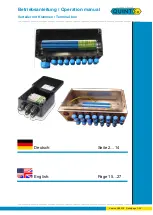
10
[0] Disable
[1] Enable
Default: [0] Disable
WEPKey Length
When WEP is enabled, Data sent between the client and the access point is
scrambled using either a 64-bit or 128-bit key. The higher the level of encryption,
the more secure it is.
[0] 64 bits
[1] 128 bits
Default: [1] 128 bits
Default Key
Activate one of the four encryption keys
Default: [1] WEP KEY1
WEP Key
Define the encryption key values for Key1~Key4 using hexadecimal digits.
When WEPKey Length “
64 Bit
” is selected, the user is required to fill in
5
bytes of
hexadecimal values as the encryption key.
When WEPKey Length “
128 Bit
” is selected, the user is required to fill in
13
bytes
of hexadecimal values as the encryption key.
3). EAP Menu
EAP
Stands for
Extensible Authentication Protocol
. SP5600 terminal only support
EAP-MD5. When these features are implemented, a wireless client that associates with
an access point cannot gain access to the network until the user performs a network
logon. Therefore,
Identity
and
Password
are needed when
EAP
is enabled.
EAP Setting
EAP ID
EAP Password
5.
Echo Tests
The terminal will echo the received data from the client or server and also signals a beep.
The function is used to measure the coverage of the range, estimate the number of APs and
terminals needed, and determine the AP’s deployment topology.
1. Client Mode
2. Server Mode
Cipherlab provides TCPServer.exe (only for Client Mode) and TCPDemo.exe for Echo
Tests.
Once the connection of Echo Test is established, the details will be displayed as the
illustration below.
Sending 033
Recv ok 033
Q: 0070 T: 11M
S: 0133
N: 0006

































